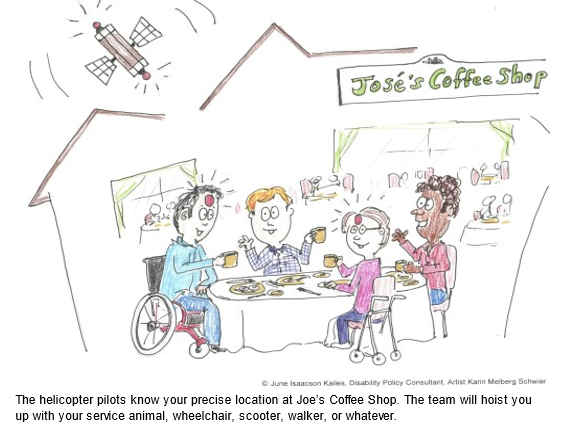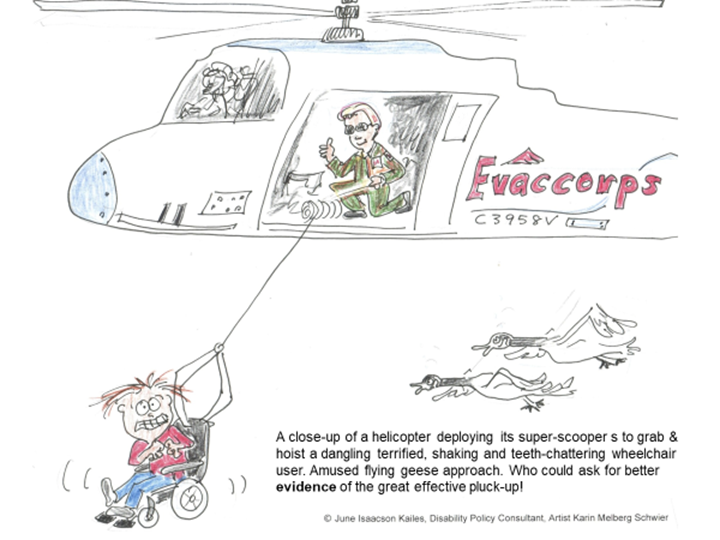Emergency planners often identify volunteer disaster registries as a solution for assisting people with disabilities before, during, and after a disaster despite serious flaws with this approach. Perhaps this is because jurisdictions do not understand that there are better options and how to implement them. The National Council on Disability (NCD) asserted in a May 24, 2019, report that it:
[C]annot overstate how detrimental registries for people with disabilities are in disasters. Stakeholders across the spectrum of disability advocates and emergency managers still struggle to find ways to make registries a viable solution to identify, rescue and evacuate people with disabilities affected by disasters despite repeated failures of registries. Registries isolate and marginalize people with disabilities and create a false sense of expectation among people with disabilities and their family members. Like institutions, registries have been proven to be an ineffective method to ensure proper evacuation and sheltering of people with disabilities during emergencies.
People with disabilities have a right to equal access to emergency services. Registries have both impeded equal access solutions and established inadequate alternatives for using federal funds. NCD recommends that no federal funds, including but not limited to federal funds from the U.S. Department of Homeland Security and the U.S. Department of Health and Human Services, be used in development, deployment, and maintenance of emergency “special needs” registries intended to include people with disabilities.
Registries, as used here – sometimes referred to as “special needs” registries – are sponsored primarily by a government as a disaster response and planning tool. The information typically collected includes at a minimum the individual’s name, location, contact information, and other details of people who voluntarily register and may need disaster help.
Registry Problems & Better Solutions
This article describes eight common problems with developing and using a volunteer disaster registry and suggests better solutions for each. The focus here is on disasters versus emergencies because local emergencies (e.g., house fires, downed power lines, and vehicle collisions) are generally dealt with using available response resources (see California Disaster Coalition Meeting, 2022; Kailes, 2023). Disasters cause severe disruptions to a community’s functioning that exceed its capacity to cope using available resources. These widespread, large-scale events may cross geographic and political boundaries and require coordinated action across multiple entities and levels of government. Disasters can include natural, technological, or human-caused events, such as earthquakes, extreme weather, hurricanes, tornadoes, heat waves, tsunamis, wildfires, mudslides, floods, droughts, pandemics, power outages, chemical spills, terrorism, and cyberattacks.
While registries may work in small local emergencies, they fail during large-scale events primarily because of the mismatch between the magnitude of the needs and the availability of resources to address disaster-related needs. Voluntary disaster registries are based on seriously flawed assumptions by planners and potential registrants that involve planning (assumptions, evidence, response capacity, and data and planning tools) and modernizing communication. Sometimes, these assumptions can lead to fatal consequences.
Planning – Assumptions
Registry Problem 1 – A registry is assumed to be a straightforward, simple, and compelling approach to including and assisting people with disabilities and others with access and functional needs before, during, and after disasters. However, this commonly held belief has not been systematically tested and usually represents dis-, mis-, and flawed information (see also California Disaster Coalition Meeting, 2022). Instead, registries are based on guestimates that lack capacity specifics, including the who, what, where, when, and how. These guesses can lead to symbolic, unproven plans and overpromises. Thus, the registry model is a flawed approach to taking care of the “disability problem” and may be an attempt to appease the community and meet the superficial requirements of a planning checklist. Although a registry may have a specifically stated purpose, such as evacuation transportation or life-safety checks after a disaster, registrants typically assume implied rescue.

Better Solution 1 – Engage the disability community in the development of plans that are tested, exercised, revised, and sustained with a commitment to a continual improvement process. Involving these disability partners helps to address implicit disability biases, discrimination, lack of access, and accommodation. The support helps prevent civil rights violations by delivering assistance that allows individuals with disabilities to participate equally in and benefit from emergency services. Contracts, agreements, and memoranda of understanding (MOUs) with these partners can help provide needed resources such as accessible transportation, Communication Access Real-Time Translation (CART), accessible transportation, sign language interpreters, and life-safety checks.
An effective partnership tool employed for the first time during the 2007 California wildfires and subsequently during disaster responses is disability emergency briefing team calls. The group consisted of staff from disability organizations, state and county governments, and the Federal Emergency Management Agency (FEMA). The calls’ focus is problem-solving regarding meeting essential unmet needs – for example, replacing left-behind, lost, or damaged consumable medical supplies and equipment such as wheelchairs, canes, walkers, shower chairs, hearing aids, etc. A similar practice started in 2018 in North Carolina during Hurricane Florence.
Registry Problem 2 – A registry is often based on the inaccurate idea that people with disabilities are sick, homebound, and in need of disaster assistance.
Better Solution 2 – Recognize that rarely is anyone homebound. The Bureau of Transportation Statistics estimated that approximately 3.6 million people with disabilities in the U.S. do not leave their homes. The U.S. Census estimated that, as of July 1, 2022, the country’s population aged 18 and over is 260.8 million, of which the Centers for Disease Control and Prevention (CDC) estimate that about 27% (70.4 million) are people with disabilities. This means that only about 5% of those with disabilities are homebound. Understand that most disabled people are not sick, nor do they live in institutions. Some people will need immediate help, and some will not. Some may even be disaster responders. (Note: These statistics are provided for reference based on available data. Due to different definitions, different timeframes, etc., the exact number of people in the U.S. with a disability varies between resources.)
Base plans on realistic projections that include people with disabilities and others with access and functional needs. People with disabilities are a “protected class.” This means protected from discrimination as defined by federal civil rights laws such as the Americans with Disabilities Act (ADA) of 1990 and other federal and state civil rights protections. Beyond the CDC’s estimated 27% of adults having some disability, others with access and functional needs may not meet the protected class definition but still benefit from these protections. These individuals can include people with the limited ability to walk, run, see, drive, read, hear, speak, remember, or understand. When planning integrates the known needs of people with disabilities, including physical, equipment, programmatic, and communication access, a larger segment of the population (others with access and functional needs) benefits. These two groups can represent 50% of the population.
Planning – Evidence
Registry Problem 3 – Evidence has not proven that registries work. Registry failures have been repeatedly exposed in multiple reports during disasters in three states. In Texas during Winter Storm Uri in 2021, some registrants reported that the paperwork was “cumbersome,” making it difficult to register. Then, after registering, those who needed help did not receive support they expected. In California, issues included keeping registries current, retrieving the data, and responding when needed. In 2004, In 2004, the Los Angeles County Office of Emergency Management conducted research that concluded that the costs of developing and implementing a voluntary registry would cost nearly $1.4 million per year for the first three years. In Florida, Hurricane Irma in 2017 highlighted issues with registrants being confused about what they were supposed to do with “special needs” registries. As a result, some were denied services because they self-evacuated or no longer met the registry’s requirements for aid. As these examples demonstrate, registry failures lower public confidence and trust.
Better Solution 3 – More research is needed that analyzes the effectiveness of existing registries’ outcomes, impacts, and results (see California Disaster Coalition Meeting, 2022). This research should consider the following factors:
- Community partnerships (see Planning – Response Capacity, Better Solution 5) response models;
- Tools individuals can use to signal for and get help (use of existing and emerging technology: apps, global positioning systems, satellite, etc.; see Modernizing Communication, Better Solution 8); and
- Community education and training that counteracts beliefs that help will come immediately (see Response Capacity, Better Solution 4).
Integrating genuine and accountable stakeholder involvement helps prevent research drifts, shifts, and sometimes a total change in the intended focus. Stakeholder involvement is “a must do, not a nice to do!”

Planning – Response Capacity
Registry Problem 4 – Emergency personnel may believe that registry disclaimers are sufficient. However, disclaimers do not mean that responders will act on or know what to do with the information, leaving registrants with a false sense of security. Despite disclaimers, registrants persistently think that, “If I register, they know where I am, and they will come to help me.” However, this belief decreases and diverts attention from developing, reviewing, and strengthening personal preparedness plans (see California Disaster Coalition Meeting, 2022; Kailes, 2023).
Better Solution 4 – Help people with disabilities and others with access and functional needs to engage in specific preparation planning. This process requires ensuring a careful thought process, taking steps toward establishing preparations, and maintaining current personal support systems, helpers, and evacuation plans. Contracts with disability-led organizations that have staff with lived experience can be effective with these tasks. For example, California’s Disability Disaster Access & Resources program, through contracts with investor-owned utilities, provides resources to people with disabilities affected by power outages common to many disasters.
Registry Problem 5 – For planners, registries may divert energy from developing specific procedures, assets, and response capacity needed for response and recovery.
Better Solution 5 – Use broad community partnerships and connections to build response capacity with government, businesses, community-based organizations, self-organizing groups, and Voluntary Organizations Active in Disasters (VOAD). It takes teamwork and hard work to build assets and resource capacity to operationalize, embed, and sustain viable and specific help. Partnering with community groups is more likely to result in better solutions and outcomes for disaster-impacted communities. For example, in Puerto Rico, the Mayor’s Office for People with Disabilities coordinated a shipment of supplies and durable medical equipment in October 2017. However, after months of delays, the release of the shipment was still denied. It took “a strong advocacy effort led by local disability advocates and supported by Portlight and the Partnership finally succeeded in the release of these critically needed goods.” These partnerships include completing and sustaining contracts and agreements for:
- Helping people with disabilities with specific, not vague, personal emergency plans;
- Conducting life-safety checks; and, when needed,
- Providing:
- Food, medications, supplies, backup power,
- Evacuation assistance from structures,
- Transportation out of and back into affected areas,
- Personal assistant services to help an individual with bathing, dressing, eating, grooming, toileting, transferring, shopping, or communicating (personal assistants can be a family member or friend, paid or volunteer, and are sometimes called attendants or caregivers),
- Telehealth and telemedicine services, and
- Sheltering, temporary, and permanent housing.
By planning with and not for people, planners can integrate diverse perspectives. However, it will take more than one meeting. Developing, refining, and sustaining specific solutions may take months or years. Planning partners must include and represent diversity in perspectives to create equitable policies and conduct planning, programs, and response capacity that include and benefit all rather than harm the most disproportionately impacted groups and communities. Planning also must not use the lens of middle-class privilege, ageism, and ableism, which includes not assuming everyone has a stable internet connection, has money to buy emergency supplies, owns a working vehicle, and can walk, run, see, hear, speak, remember, and understand.
Planning – Data and Planning Tools
Registry Problem 6 – A voluntary list is perishable and can quickly become outdated because registries may be difficult to keep current.


Better Solution 6 – Partner with disability community organizations and vendors (independent living centers, durable medical equipment, and consumable medical supply providers, etc.) that actively support people, customers, clients, consumers, and members, because their contact information is more frequently updated (see California Disaster Coalition Meeting, 2022; Kailes, 2023).
Registry Problem 7 – Planners may assume that registries are good planning tools because of the expectation that “when you register, responders will know how many will need help, and they can plan accordingly.” This assumption is false because registries are always incomplete, as they include only a small percentage of people who may need assistance. People with disabilities may not register because they do not believe registries work, have privacy reasons, are fearful of being tagged as vulnerable, have concerns regarding legal status for themselves or their family members, or are afraid of losing their independence. Using a registry to define the size of the population that will need disaster assistance is a convenience sample that results in inadequate baseline numbers. This approach is dangerous and violates civil rights protections of people with disabilities who are not in the registry.
Better Solution 7 – Utilize more accurate planning data tools and ways to define needs (see California Disaster Coalition Meeting, 2022). Data sources for these tools could include:
- Program administrative data from sources such as human service agencies, social security, Veterans’ Administration, etc. (e.g., Florida’s County Profiles for Access and Functional Needs provides examples of both survey data sources and administrative data sources. A link at the bottom of the county profiles shows the data sources used) show locally relevant data for people with disabilities and other access and functional needs within jurisdictions;
- Census Data;
- Social Vulnerability Index; and
- FEMA’s Resilience Analysis and Planning Tool.
Modernizing Communication
Registry Problem 8 – Because most people with disabilities are not homebound, knowing where people live does not tell where people are before, during, and after a disaster.
Better Solution 8 – The focus must be on modernizing how people communicate when they need help and what they need versus assuming all people with disabilities need the same support and are in fixed locations (see California Disaster Coalition Meeting, 2022). When people can signal their need for help or the status of their safety, it eliminates the need for non-inclusive registries that use out-of-date lists and lead to unnecessary calls, wasted trips, and lost time for overstretched, scarce first responders and volunteers. Diverse applications and options for smartphones and wearables (like smartwatches) have applications and integrated sensors with prompts for users, such as “It looks like you have had a hard fall. Press emergency, SOS, or press I’m OK.” Use and improve the technology which:
- Allows signaling for help by a call, text, email, or button press;
- Uses precise location services and sensor technologies; and
- Uses global positioning system-enabled applications that allow users to choose contacts who can track their locations in real-time, and contacts receive an “I’m Safe” or “Need Help” message to their selected lists.
Implementing Better Solutions
The eight registry problems outlined above highlight some of the problems with using disaster registries for people with disabilities. As American journalist and scholar H.L. Mencken said, “For every complex problem, there is an answer that is clear, simple, and wrong.” Understanding the flaws in these assumptions and possibilities for better solutions and outcomes is the first step toward providing more effective support and safety for the diverse communities of people with disabilities and others with access and functional needs. Hold each other accountable for the partnerships, hard work, and problem-solving needed to create, embed, deliver, and sustain real impacts and outcomes. The time is now to make changes to help people protect their health, safety, and independence and successfully cope with and live through the increasing and inevitable disasters.
Additional Resources
California Disaster Coalition Meeting: Emergency Registries: A Misleading, Harmful & Non-Inclusive Fix:
- Part 1 (2022, September 8) https://www.youtube.com/watch?v=mexNCwt1lw8and,
Slides: http://www.jik.com/2022%2009-08RegistriesSlides.pdf. - Part 2 (2022 October 13) https://www.youtube.com/watch?v=oRyvS9TG1QQ,
Slides: https://mcusercontent.com/ee4ede4e4b843b579fff1fd86/files/6b7b1548-e1bd-a95b-c7ca-949ae83cc6c5/2022_10_13_registriesslides.pdf
J. I. Kailes (April 10,12, 2023) Disaster Registries for People With Access & Functional Needs: Pivoting the Model to Address Real Solutions, Colorado’s 3rd Annual Access and Functional Needs Conference – Getting it Right: A “Plan With” Approach:
- Pre-Conference 1 (at 17.55-minute mark), https://www.youtube.com/watch?v=b412qBC3zaI&list=PLQDCae5hPt4aKzkVv1KRaQIygqo-YQRDK&index=2.
- Day 2 (at 17.05-minute mark), https://www.youtube.com/watch?v=OIEaGWeKtGY&list=PLQDCae5hPt4aKzkVv1KRaQIygqo-YQRDK&index=8

June Isaacson Kailes
June Kailes, a disability policy consultant (jik.com), has over four decades of experience as a writer, trainer, researcher, policy analyst, subject matter expert, mentor, and advocate. June focuses on building disability practice competencies and health care and emergency management capabilities. She uses actionable details, the “how, who, what, where, when, and why,” to operationalize the specificity needed to include people with disabilities and others with access and functional needs. June’s work converts laws, regulations, and guidance into tangible building blocks, tools, and procedures that close service gaps, prevent civil rights violations, and deliver inclusive, equally effective services.
- June Isaacson Kaileshttps://domesticpreparedness.com/author/june-isaacson-kailes
- June Isaacson Kaileshttps://domesticpreparedness.com/author/june-isaacson-kailes
- June Isaacson Kaileshttps://domesticpreparedness.com/author/june-isaacson-kailes






